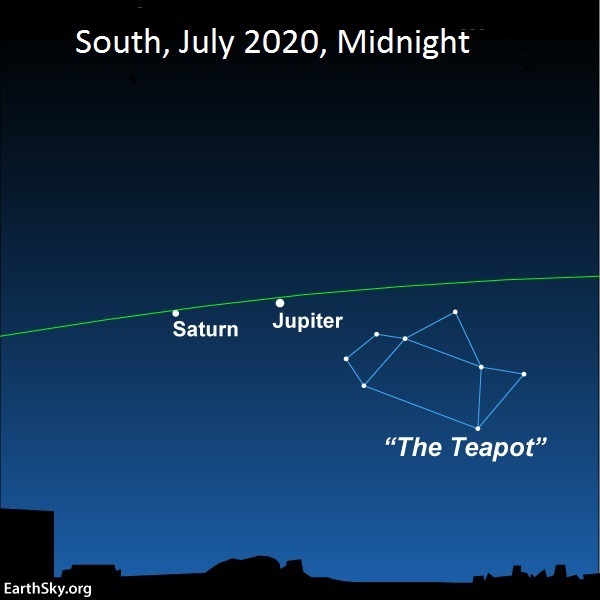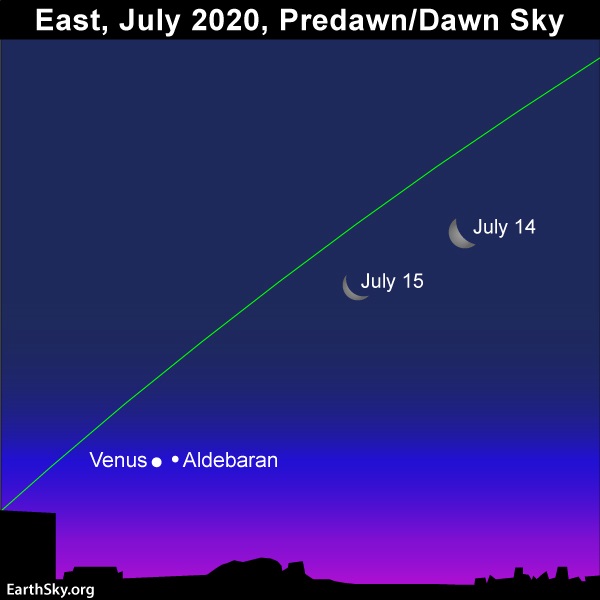
On the night of July 13-14, 2020, our planet Earth flies between the sun and the biggest planet in our solar system, mighty Jupiter. Our faster motion places Jupiter – an exceedingly bright planet in our sky – opposite the sun. Jupiter is now rising in the east as the sun is setting below the western horizon. Astronomers call this event an opposition of Jupiter.
Jupiter reaches opposition on July 14, 2020, at 8:00 UTC; translate UTC to your time. At United States’ time zones, that’s 4 a.m. Eastern Time, 3 a.m. Central Time, 2 a.m. Mountain Time, 1 a.m. Pacific Time, 12 midnight July 13-14 Alaskan Time, and on July 13, at 10 p.m. Hawaiian time.
Opposition marks the middle of the best time of year to see a planet. That’s because it’s when the planet is up all night and generally closest for the year (the exact date of Jupiter at its closest this year is June 15).
Jupiter’s opposition is doubly exciting this year, because golden Saturn is near Jupiter on the sky’s dome. Saturn’s opoosition will come less than a week from now, on July 20.
Both Jupiter and Saturn are in front of the constellation Sagittarius the Archer. It’ll remain in Sagittarius till late December 2020. You probably won’t see an Archer in the stars around Jupiter, but, if your sky is fairly dark, and if you let your eyes wander among the stars, picking out patterns, you might notice the pattern of a Teapot near Jupiter and Saturn. This famous Teapot in Sagittarius marks the direction to the center of our Milky Way galaxy.
Read more: Before 2020 ends, a great conjunction of Saturn and Jupiter

Jupiter reaches opposition on July 14, 2020, and about a week later, Saturn sweeps to opposition on July 20, 2020. Both are in front of the constellation Sagittarius. Jupiter is very bright. With the exception of the sun and moon, only Venus – the brightest planet, now low in the east before sunrise – outshines Jupiter. Saturn appears as a golden “star” a short hop to the east of Jupiter. In July 2020, these two worlds ascend in the east in the evening hours and climb highest up for the night around midnight (middle of the night). A month from now, the dynamic twosome will be highest up for the night around mid-evening.
Jupiter is now in the east around sunset. It climbs highest in the sky at midnight (that is, midway between sunset and sunrise). It sets in the west around sunrise.
As the biggest planet in our solar system, Jupiter is always bright. It shines more brightly than any star in the evening sky. There’s no way to mistake Saturn for Jupiter, though, because dazzling Jupiter outshines this 1st-magnitude planet by some 14 times.
Among starlike objects in our sky, only Venus is brighter than Jupiter. And Venus is up in the east before sunrise now … nowhere near Jupiter on the sky’s dome. In fact, this week and next, it’ll be possible to see Jupiter and Venus together at morning dawn, on opposite sides of the sky. Venus will be blazing low in the east while Jupiter is sitting low in the west, shortly before sunup. You’ll need an unobstructed horizon in both directions to see both Venus and Jupiter before sunrise. As the minutes tick by, and the light of dawn rises, Venus will be ascending higher in the eastern sky. Meanwhile, Jupiter will be descending in the west.

Up before daybreak? The illuminated side of the waning moon will be pointing at Venus, the sky’s brightest planet, on the mornings of July 14 and 15, 2020. The bright star near Venus this week is Aldebaran, the Eye of the Bull in the constellation Taurus.
Jupiter comes to opposition roughly every 13 months. That’s how long Earth takes to travel once around the sun relative to Jupiter. As a result – according to our earthly calendars – Jupiter’s opposition comes about a month later each year.
Last year – in 2019 – Jupiter’s opposition date was June 10.
Next year – in 2021 – it’ll be August 19.
Read more from Guy Ottewell: Jupiter’s opposition in Sagittarius
Jupiter isn’t a rocky planet like Earth. It’s more like a failed star, not massive enough or hot enough inside to spark thermonuclear fusion reactions, but some 2.5 times more massive than all the other planets in our solar system combined. You’d need some 80 Jupiters – rolled into a ball – to be hot enough inside for thermonuclear reactions … for Jupiter to shine as stars do.
Yet on this July night – as Jupiter rises opposite the sun – you can imagine it beaming down on us as a tiny sun all night long.

Jupiter (red) completes one orbit of the sun (center) for every 11.86 orbits of the Earth (blue). Our orbit is smaller, and we move faster! Animation via Wikimedia Commons.
Bottom line: Look for Jupiter on the night of July 13-14, 2020, as this world comes to opposition, the point opposite the sun in our sky.
Read more: How to see Jupiter’s moons
Read more: Why is Jupiter closest after we go between it and the sun?
Donate: Your support means the world to us
Source:
https://earthsky.org/tonight/earth-passes-between-jupiter-and-sun